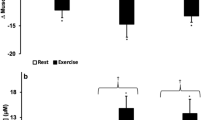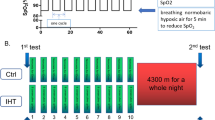We studied the effects of hypoxic, hypercapnic, and hypercapnic-hypoxic exposures on brain tolerance to ischemia. All respiratory training modes had a neuroprotective effect, but the most pronounced effect was observed after exposure to hypercapnic hypoxia. Experimental stroke in rats preliminary exposed to hypercapnic hypoxia was associated with minimal neurological defi cit and motor coordination disturbances in comparison with training modes.
Similar content being viewed by others
References
A. G. Bespalov, V. P. Kulikov, A. V. Lepilov, Patol. Krovoobr. Kardiokhir., No. 3, 60-63 (2004).
L. D. Luk’ianova, E. L. Germanova, T. A. Tsybina, et al., Patogenez, No. 3, 32-36 (2008).
W. Balduinin, V. De Angelis, E. Mazzoni, and M. Cimino, Brain Res., 859, No. 2, 318-325 (2000).
X. Gao, C. Chang, D. Duan, et al., J. Yuazhong Univ. Sci. Technolog. Med. Sci., 26, No. 1, 17-20 (2006).
L. Katz, U. Ebmeyer, P. Safar, et al., J. Cereb. Blood Flow Metab., 15, No. 6, 1032-1039 (1995).
V. P. Kulikov, A. G. Bespalov, and N. N. Yakushev, Neurosc. Behav. Physiol., 39, No. 3, 269-273 (2009).
U. Lindauer, J. Vogt, S. Schuh-Hofer, et al., J. Cereb. Blood Flow Metab., 23, No. 10, 1227-1238 (2003).
T. P. Obrenovitch, Physiol. Rev., 88, No. 1, 211-247 (2008).
E. Rybnikova, T. Glushenko, E. Tulkova, et al., J. Neurochem., 106, No. 3, 1450-1458 (2008).
M. P. Stenzel-Poore, S. L. Stevens, J. S. King, and R. P. Simon, Stroke, 38, No. 2, Suppl., 680-685 (2007).
Y. Sun, Y. B. Ouyang, L. Xu, et al., J. Cereb. Blood Flow Metab., 26, No. 7, 937-950 (2006).
R. C. Vannucci, J. Towfighi, S. J. Vannucci, J. Neurochem., 71, No. 3, 1215-1220 (1998).
S. Zakynthinos, P. Katsaounou, M. H. Karatza, et al., Am. J. Respir. Crit. Care Med., 175, No. 1, 62-68 (2007).
L. Zhan, T. Wang, W. Li, et al., J. Neurochem., 114, No. 3, 897-908 (2010).
Q. Zhou, B. Cao, L. Niu, et al., Anesthesiology, 112, No. 2, 288-297 (2010).
Author information
Authors and Affiliations
Corresponding author
Additional information
Translated from Byulleten’ Eksperimental’noi Biologii i Meditsiny, Vol. 155, No. 3, pp. 302-304, March, 2013
Rights and permissions
About this article
Cite this article
Tregub, P.P., Kulikov, V.P., Bespalov, A.G. et al. Neuroprotective Effects of Individual or Combined Exposure to Hypoxia and Hypercapnia in the Experiment. Bull Exp Biol Med 155, 327–329 (2013). https://doi.org/10.1007/s10517-013-2145-x
Received:
Published:
Issue Date:
DOI: https://doi.org/10.1007/s10517-013-2145-x




